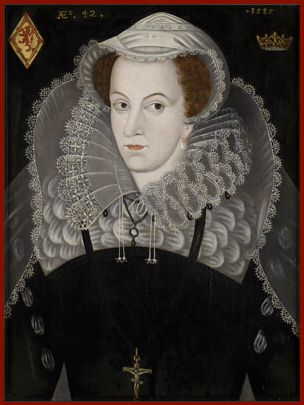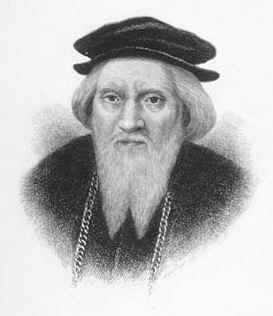During Queen Elizabeth's reign, England
rose to become a great naval power. And one of the most important
men to make this happen was Sir Francis Drake.
He was born in humble circumstances in
1540 and started as a cabin boy. Because of his sheer determination
and hard work, he rose to the highest rank in the English navy.
In 1567, he was on a slave trading
voyage in the West Indies. They were driven off course by a bad
storm, and had to seek shelter in the harbor of San Juan de Ulua, a
Spanish port on the coast of Mexico. At first they were received with
kindness, but were afterward attacked by bigger ships, and only
escaped with two vessels. After this act of treachery (evil
plotting), Drake decided that he would take every opportunity in the
future to rob and plunder the Spanish to pay them back for this
betrayal.
After 1570, Drake made many voyages to
the New World to spy on the Spanish and steal as much stuff from them
as possible. In Panama, he planned on capturing an entire Spanish
town where they were shipping gold and silver from Peru, and take it
for England. But he got wounded badly, and they had to give up the
plan.

But from then on, he would sail up and
down the coast, seizing a large number of ships and taking the
Spanish wealth, both in money and goods. He even decided to hike
across the isthmus of Panama and from a tree on a hill, he was able
to see both the Atlantic and Pacific oceans.
Drake returned to England in 1573 with
many riches. He bought three new ships and set out to sail around
the world. He followed the same path that Magellan, the Portuguese
navigator had taken 70 years before. When they got around Cape Good
Horn in South America, he lost several ships and some turned back.
But Drake kept going with his single ship, the Marigold. On the
western side to North America, he plunder lots of Spanish
settlements, with the permission and blessing of Elizabeth I.
Frances Drake stopped to make repairs at a place called Drakes Point
(named after him) in the San Francisco Bay area. Then he set sail
across the Pacific Ocean.
It took Drake exactly 2 years and ten
months to sail around the world. There was a big banquet on his ship
and Queen Elizabeth was one of his guests. This is where Drake
became a knight with the title 'Sir'. The Marigold couldn't sail
anymore, but it was made into a monument that lasted 100 years until
it was too rotted. But they saved a piece of the wood and made it
into a chair for King Charles II, who afterward gave it to the
University of Oxford, where it can still be seen today!
A few years later, Sir Francis Drake
would help to save England. King Phillip of Spain was planning to
invade England (remember Mary Queen of Scots?) and had a large fleet
of ships in a harbor in Cadiz. Drake sailed quickly to Cadiz and
sent a fire ship into the harbor, destroying nearly 100 ships and was
able to escape unharmed. This delayed the Spanish invasion 1 year.
But the Spanish still collected over
130 vessels and more than 50,000 men, which was called the
'Invincible Armada'. They planned to attack the English in three
different places. They thought the English would be so bewildered
that they would just surrender.
But the English were ready. Troops
were collected in case the Spanish landed on English soil. The queen
gave a rousing speech to encourage her people. Merchants offered
their ships for the fight, the rich donated money, the poor
volunteered to fight. The English didn't have half the soldiers that
the Spanish had, but they were tough. Sir Francis Drake was one of
the commanders, along with Howard, Frobisher, and Hawkins. In Late
July 1588, the coast of England was lit with warning beacons telling
the news of the Spanish invasion. They were coming.
The English vessels were light and
could maneuver easily. The Spanish had large, clunky ships. The
English sailed with skill and could fire their guns with precision.
The Spanish guns would sail over head. The fighting went on for a
week! Finally the Spanish fleet went back to the harbor in France
and the English couldn't attack. So once again, they sent 8 fire
ships into the harbor. It didn't destroy any ships but it scared the
Spanish and they sailed out to sea again. The English attacked and
many ships were disabled and 4,000 Spaniards were killed in one day's
fighting.
The Spanish wanted to sail home, but
were blocked by the English fleet. They decided to sail around
Scotland, but bad weather pushed most of the ships onto jagged rocks
and the Spanish Armada was annihilated, like completely destroyed.
Only 54 vessels made it home and 10,000 men survived.
England was victorious.
But Sir Francis Drake was not done
sailing. He took another trip to the West Indies to try to capture a
Spanish town on the Panama isthmus. But he caught a fever and died
on board his ship on January 28, 1596.
Sir Francis' body was buried at sea.
Lord Macaulay wrote these lines in reference to his burial:
“The waves became his winding sheet:
The waters were his tomb.
But for his fame-the mighty sea
Has not sufficient room.”
He left no children, but his nephew was
made a baronet in the reign of James II. England will always remember
with gratitude the services Sir Francis rendered in the days of her
struggle to become 'mistress of the sea.'
-from Famous Men of Modern Times
by John H. Haaren & A.B. Poland, 2008 Memoria Press






